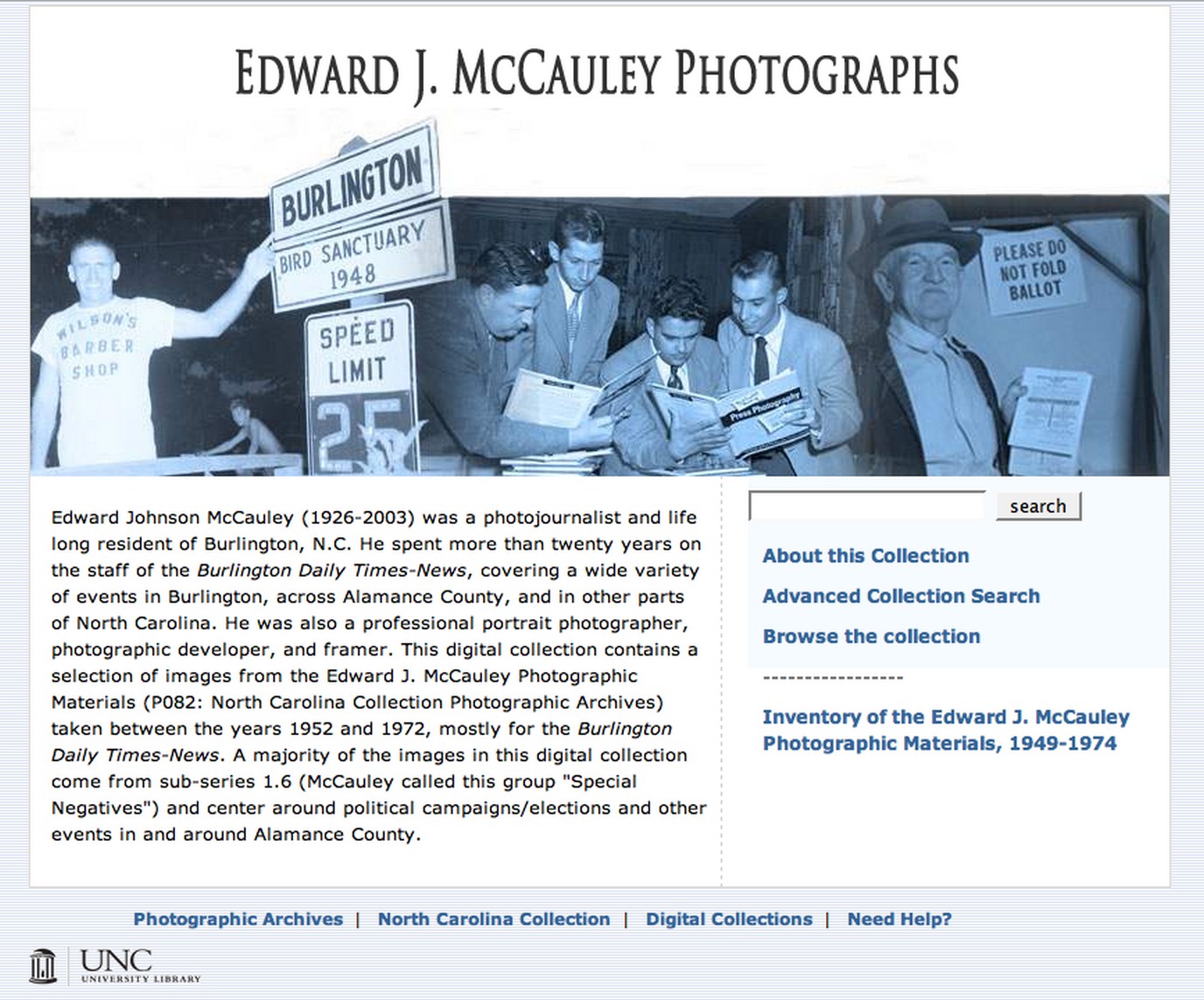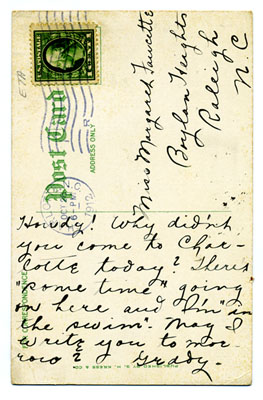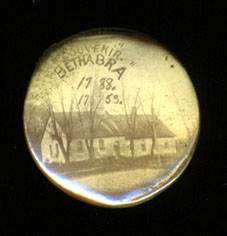The Bush White House has chosen (again) a North Carolina-grown tree for its final Christmas celebration in office. The tree, which comes from River Ridge Tree Farms in Ashe County, will be cut today and transported to Washington. Read more about the story here.
Month: November 2008
Thanksgiving In North Carolina, 1777
This time of year just begs for a Thanksgiving-oriented post. As I was racking my brain trying to come up with a suitable one, I remembered something that had caught my eye several years ago. It is a “Proclamation by Richard Caswell concerning a day of thanksgiving.” Caswell was the first governor of the newly independent state of North Carolina, and in his proclamation he declared that November 28, 1777, would be a day of “General and Solemn Thanksgiving.” For what were we giving thanks? It was for General Horatio Gates and his army’s surprising victory over British forces at Saratoga, New York.
You can read the entire proclamation here: Proclamation by Richard Caswell concerning a day of thanksgiving [as printed in the North-Carolina Gazette].
Southern Sources
It’s been on our blogroll for a few months, but our friends on the 4th floor of Wilson Library are officially launching “Southern Sources.”
The staff at the Southern Historical Collection hope to use “Southern Sources” as a way to highlight some of the deeply hidden gems in the SHC and as a way to encourage a greater level of public engagement with archival materials in general. Through regular posts, Southern Sources will show off interesting staff finds, curiosities, old favorites, and other samples from our collection.
So, after you’ve finished reading about Blenheim Ginger Ale and the verities of golf, take a look at Southern Sources.
Not-So-Soft Drink
While spending another enjoyable visit to the those two fine reference works, the South Carolina Encyclopedia and the Encyclopedia of North Carolina, it struck me that my adopted state of North Carolina appears to have pulled substantially ahead of my native state of South Carolina in the important field of soft drinks. Cheerwine, a cherry flavored drink of regional fame, was developed in Salisbury, North Carolina, in 1917, and Pepsi, one of the national giants of cola drinks, was first brewed in New Bern, North Carolina, in 1893.

However, appearances, as the old adage says, can be deceptive. South Carolina may not be the home of a giant like Pepsi, but it can boast that it gave the world Blenheim Ginger Ale, particularly the variety known and loved as “Old Number Three.” First concocted in Blenheim, South Carolina, in the 1890s, by Dr. C. R. May as an aid to digestion, the drink was a mixture of local mineral water and Jamaican ginger. I don’t know what kind of punch it packed at the turn of the twentieth century, but I vividly remember my first taste some sixty years later. My tongue burned; my throat constricted; my eyes watered; and I sneezed my head off. What a pop! Restricted for years to the area in which it was produced, Blenheim has been distributed a bit more widely of late. I can usually find it somewhere in Durham or Chapel Hill and have delighted in introducing it to my friends — at least they were my friends.
Edward J. McCauley Digital Collection Goes Live
We are pleased to announce that a new digital collection has been created which contains images from a recently processed collection in the Photographic Archives: the Edward J. McCauley Photographic Materials. This collection contains photographs taken by Edward J. McCauley (1926-2003) as a photographer for the Burlington Times-News in Burlington, North Carolina between the years 1950 and 1972.
The digital collection represents only a small percentage (around 600 images) of the nearly 90,000 images found in the Edward J. McCauley Photographic Materials (P082: North Carolina Collection Photographic Archives). A majority of the images found on the site come from sub-series 1.6 (McCauley called this group “Special Negatives”) and center around political campaigns/elections and other events in and around Alamance County. There are also numerous images from North Carolina Gubernatorial Inauguration Ceremonies (1953-1973) held in Raleigh.
New images will be added to this digital collection in the near future. Topics could include tobacco production (Alamance County), illicit liquor production (Alamance County), Miss North Carolina Beauty Pageants (held in Burlington), Boy Scouts of America (Alamance County), and Girl Scouts of America (Alamance County).
Oh, You “Creepers” And Your Hickory Postcards!
While browsing the North Carolina postcards this Sunday afternoon, I was struck by a rather humorous message to a Miss Daisy of Lattimore, NC, that relates to the vernacular of today’s language. Have you ever heard of anyone described as a “creeper”? Apparently, lots of people (males, mostly) fit the description: awkward passerbys, stalkers at Alpine Bagel, hunchbacks of Notre Dame, Drouets from Sister Carrie, etc. The list is endless and, well, Chapel Hill is a rich contributor of these seedy figures (ever visit a certain corner in Davis Library?)
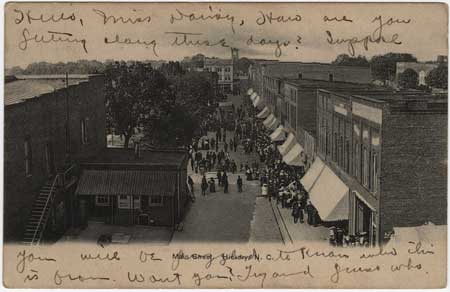
In this particular postcard featuring Main Street of Hickory, NC, we gain scope into the psyche of…of… well, we don’t know his name (the point!). The message reads:
“Hello, Miss Daisy, How are you getting along these days? Suppose you will be puzzled to know who this is from, Wont you? Try and guess who.”
Does Miss Daisy ever guess the name of her addresser? Was this merely flirtatious- October-of-1906-romance in action? Or, rather, the vicious intent of a “creeper” extraordinaire?! We’ll never know, I suppose, but the view of Main Street in Hickory is rather nice!
Thanksgiving Menu, 1960
In October, I shared with you a menu from the Chuck Wagon Restaurant in Boone, NC. In honor of the upcoming Turkey Day, I’ll share with you another menu collected by one of our former curators, William S. Powell. I don’t know about you, but I’m ready to dig in.
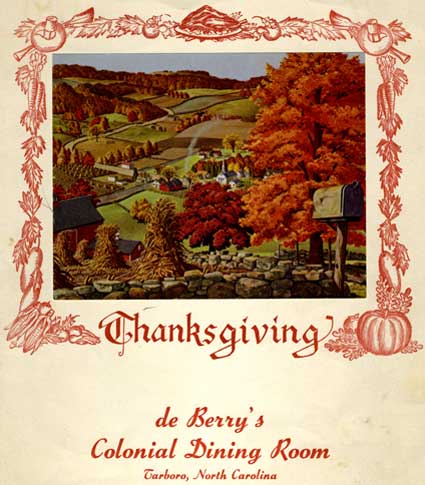
Postcards And Slang – I’m Out Of The Swim.
Even though most messages sent via postcard are fairly standard updates about the weather and/or places of interest, it often feels a bit voyeuristic to be transcribing these messages from the more or less distant past. Every once in a while I come across a card that has to be shared because it presents some pretty funny content.
Grady, the sender of the card below, offset his slang phrases in quotations which made it easy for me to notice them more than 95 years after the card was mailed. He writes, “Howdy! Why didn’t you come to Charlotte today? There’s “some time” going on here and I’m “in the swim.” May I write to you tomorrow? Grady.”
When I showed some co-workers my find, we immediately began looking for definitions and references to the phrase “in the swim.”
Like any good librarian, my boss checked the OED. Sure enough, “in the swim” has been in use since 1869, meaning, “the current of affairs or events, esp. the popular current in business, fashion, or opinion; chiefly in phr. in (out of) the swim.”
And as for “some time?” That could mean any number of things, and we’ll leave that to your own imagination of what the movers and shakers of 1910s Charlotte were doing.
Button From Bethabara
Our recent post about the arrival of the Moravians in North Carolina prompted a comment which reminded us that the North Carolina Collection has a pinback button that features a real photo view of the Moravian Church quite similar to photograph used to illustrate Harry McKown’s ‘This Month‘ article.
This image is not to scale – the button itself is rather small, maybe half an inch in diameter. Curiously, the button reads, “Souvenir. Bethabra 1788. 1753.” My first thought was that the button was commemorative of the 35th anniversay of the arrival of the Moravians. My boss kindly pointed out that my theory that the photograph and button dated to 1788 was unlikely, as the process of chemical photography was, excuse the pun, not yet developed.
Tar Heel Treasures
If you haven’t done so already, check out WRAL’s “Tar Heel Treasures.” From Scaly Mountain General Store to the Bogue Inlet Pier, it’s a great way to view North Carolina.

